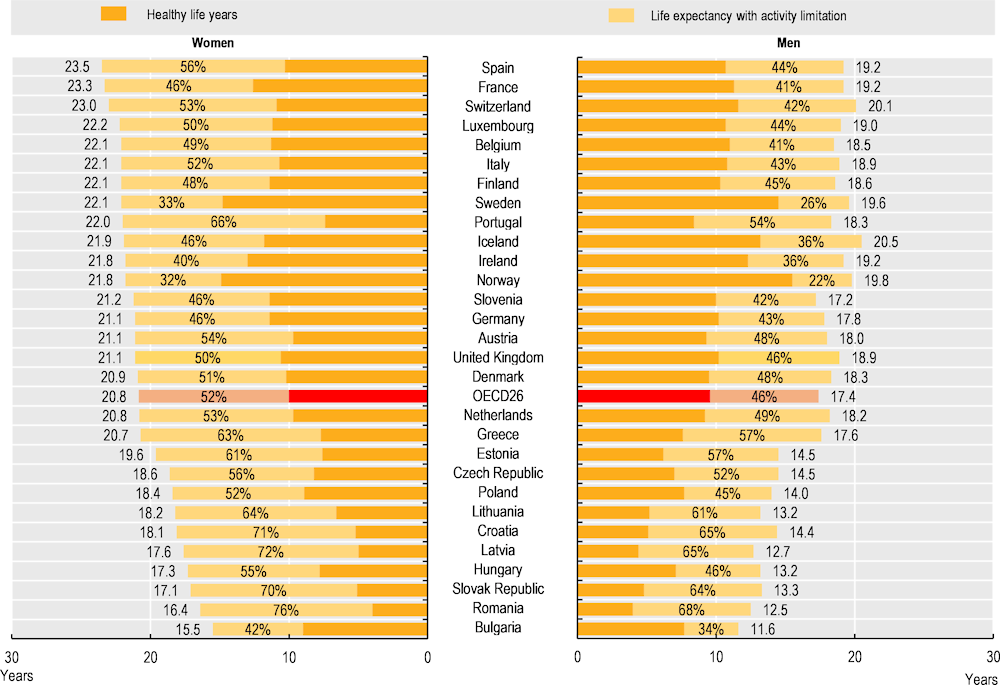Living Longer and Better: What the OECD Reveals About Real Longevity After Age 65

FIFTIERS | Life Begins at 50. La vida comienza a…
The global picture of aging is transforming rapidly. We are not only living longer — we are living differently, with new expectations about health, autonomy and quality of life. But how many of those extra years are actually lived in good health? And how do countries differ in the experience of aging?
The OECD’s “Health at a Glance 2025” report offers one of the clearest insights into how longevity is evolving across developed nations. Its findings matter deeply to the 50+ generation and to anyone preparing for a longer, more active, more fulfilling future.
Twenty More Years of Life After 65 — But Not the Same for Everyone
According to the OECD, someone turning 65 today can expect to live around 20 additional years. A few decades ago this would have sounded extraordinary — now it’s the norm in most developed countries.
But two important realities stand out:
1. Longevity continues to rise, but at a slower pace
We are still living longer, yes, but the increase is not as fast as it was during the early 2000s. Improvements in medical care, lifestyle and nutrition continue to add years, though the acceleration has softened.
2. The quality of those extra years varies sharply between countries
Life expectancy is one thing; healthy life expectancy is another. The gap between them can be wide.
Across OECD countries:
-
Women enjoy around 18 healthy years after age 60.
-
Men enjoy around 16 healthy years.
This gap between years lived and years lived in good health is becoming one of the major challenges shaping the future of aging.
The Health Gap: A Growing Divide
The differences between countries are not small — they define the lived reality of older adults. Some nations have managed to maintain high levels of wellbeing well into the 70s and 80s, while others face sharper declines in mobility, autonomy and overall health.
Several factors explain this divergence:
-
Access to strong preventive healthcare systems
-
Investment in active aging programs
-
Socioeconomic inequality
-
Nutrition and lifestyle patterns
-
Age-friendly environments — or the lack of them
The OECD stresses that prevention and early detection must become priorities in order to reduce this widening gap.
A New Model of Care Is Needed for a Longer Future
The report also emphasizes something crucial: traditional healthcare alone cannot support societies where millions will live well past 80 and 90.
The future depends on a new model built on:
Prevention as the central pillar
Regular exercise, nutrition, screening programs and mental-wellbeing strategies must become routine, not optional.
Community-based care and environments that support autonomy
Cities, neighborhoods and local services must adapt to older adults who are active and engaged, not passive recipients of care.
Technology as an ally of aging
AI-powered health monitoring, home-based diagnostic tools, safety sensors and remote health platforms will be essential to extend independence.
Aging well will not be a coincidence — it will be the result of systems designed to support longer lives.
The 50+ Generation: Leading a New Era of Longevity
For those currently between 50 and 70, these findings are more than statistics: they are a roadmap.
The OECD identifies three decisive factors for enjoying long, high-quality years:
-
Protecting health early in midlife
-
Understanding the risks and opportunities of a longer future
-
Embracing habits and technologies that support vitality and independence
The generation entering its 50s and 60s today is redefining aging. They are educated, engaged, digitally connected, and determined to shape their own future — not simply accept it.
Conclusion: Living 20 More Years Is Possible; Living Them Well Is the Real Goal
We are entering an era in which turning 65 is no longer an end point — it is a transition into a stage rich in possibilities. The key question is no longer How long will we live? but How well will we live?
The OECD is clear: societies must invest in prevention, innovation, and environments that support autonomy.
At FIFTIERS, we will continue giving voice to the generation that is breaking every previous model of age, health and longevity.
And the best is yet to come.
“Health at a Glance 2025” – Organisation for Economic Co‑operation and Development (OCDE)
Discover more from FIFTIERS
Subscribe to get the latest posts sent to your email.
















